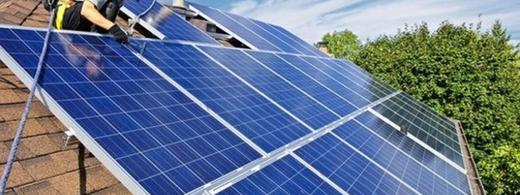Let’s flash forward and assume you’ve done the research, have contacted a reputable solar installer, and are ready for installation. What’s involved? And how soon will you start to notice your return on investment?

Let’s start by talking about what really happens when you install solar panels in your home, and how they convert sunlight into energy. First, solar panels convert sunlight to DC current. An inverter (part of your solar power system that converts stored energy into voltage needed to run standard electrical equipment) converts this DC electricity to AC. Your home takes the energy it needs based on the number of electrical units requiring energy. If your residential solar system is also connected to the grid, any extra , unused electricity, is fed back to the grid (or to a battery, if you have a battery backup). In cases like this, you are typically eligible for something called net metering. This is essentially a credit that is given to your energy account from the utility company. When you draw energy from the grid (because you no longer have enough solar energy to consume), net metering compensates for the amount of energy you gave the grid. In essence, it’s possible to come out with a zero balance because what you put into the grid (from your solar panels) is roughly the same amount that you took from the grid (e.g., during nighttime).

In some extremely rural places, with limited or no grid availability, you may install home solar systems that are not connected to the grid. Your sunlight conversion is the same; however, you won’t have the option of connection to the grid when you run out of solar energy. This type of solar electrical system requires considerable monitoring of your energy use to make sure you have enough energy to get you through the day.
Before anything is installed, a solar engineer will come to your home and assess your home for the proper type of installation – asking you and consulting on the following things:
* How much sun will you have
* Where will the system be placed (on the roof, on the ground)
* How big will the system need to be to satisfy your energy needs
* Will you be connected to the grid or not connected to the grid
* How can you optimize the safety and functionality of the system once installed
Once you have gone over these things, and the solar engineer has recommended the best solar system for your residential needs, the solar panel installation process can begin.
When it comes to solar panel installation, hiring a professional is the best route. These individuals are well-versed in solar energy, know the ins and outs of installation, can maximize your return on investment by installing and positioning the panels correctly, and can give the system a once-over to make sure everything is safe for use.

There are some things you’ll need to consider prior to choosing a solar installer. Here are the most important things to consider:
* How much experience does the installer have installing solar panels?
* Are you dealing with a licensed and reputable solar installer?
* Have you contacted your state electrical board to determine if the solar company you are dealing with has any pending or active judgments or liens against it?
* Have you gotten multiple bids for the project?
Once you have done all your homework, done your due diligence, and chosen a contractor, it’s time to get started!
The entire installation process averages about two days. But, that doesn’t mean once you’ve decided on what type of system you want installed, they’ll be up and running by the end of the week. The installation process can be long and drawn out, because of the number of contracts that are involved. Once you’ve chosen your system, and if you’ll be connecting to the grid (as the overwhelming majority of homeowners with residential solar systems do), you’ll have to sign contract upon contract. One with the installer. Another with the electrical company. But, it doesn’t stop there. Once you sign your contract with the electric company, they’ll need to approve it, because you will be tying into their grid. The electric company will have a number of hoops that your system will need to pass through, including the efficiency of the system and the safety of the connections. Because we’re dealing with electricity, any malfunction or safety issue can be a huge pickle for the utility company and its equipment.

What other types of consultation will you need to have? If you’re installing solar panels on your roof, a roofing contractor will need to come out to determine if your roof can bear the weight of the solar panels. These types of “hang-ups” with the contractors can take weeks for approval. Then, you’ll need to work yourself into the installation schedule of the solar installers. So, what seems to be a simple two day process, could in fact, take a couple of months when it’s all said and done. What’s the payback? The money you’ll be saving on your first energy bill. And the financial incentives you get to take advantage of by going green and reducing your carbon footprint!
subscribe and keep yourself updated with the newest products and deals

